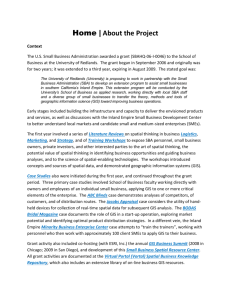After Losing 8.78 Million Jobs
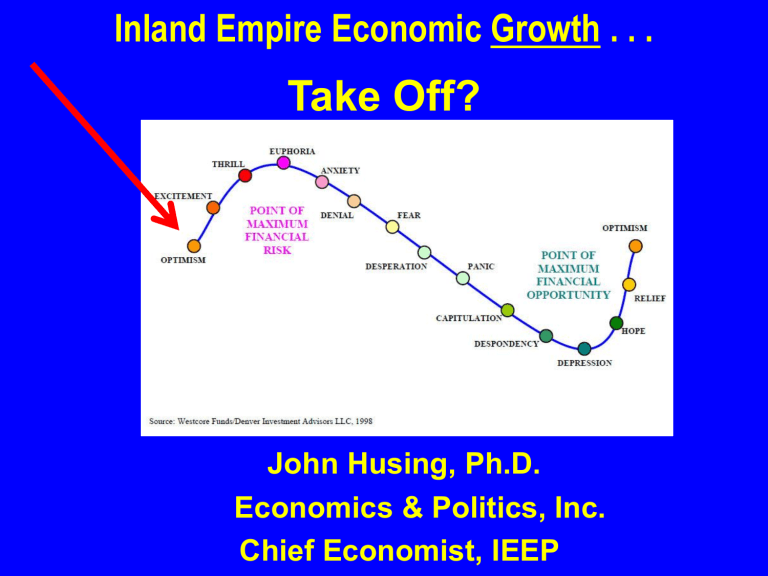
Inland Empire Economic Growth . . .
Take Off?
John Husing, Ph.D.
Economics & Politics, Inc.
Chief Economist, IEEP
After Losing 8.78 Million Jobs …
U.S. Jobs Are Still Crawling Back
-664,000 Government Jobs
+8,221,000 Private Sector (94.1%)
Unemployment Falling, But High
Worst U.S. Metropolitan Area
Unemployment Rates
How Regional Economies Work
Secondary Tier
Economic Development … Increase The Economic Base!
Primary Tier
Three Step Growth Process
Based On Interaction Of:
• Population
• Preferences
• Dirt
Prices Force Decisions
Southern California Population Growth,
2000-2012
People Prefer To Live Near The Coast
As a homeowner, would you prefer to move closer to work if it involved a townhouse or condo?
(I-15 & Sr-91 Commuters, 2008)
87.5% No
Answer stable over 5 years
Same question to Renters:
72.3% No
Stage #1: Rapid Population Growth
• People forced to move inland for affordable homes
• Population Serving Jobs Only
• High Desert & I-215 South are current examples
Commuting Bad, But Stable Over Time
1,650,384 Total Jobs
1,156,313 Inside IE
494,071 Commute Outside County
154,845 Between IE Counties
339,226 Outside IE
20.6% Commute Outside the IE
16.3% Orange County Commuters
Construction: Finally Some Hope
Share of Underwater Homes Plunging
4Q 2012 to 3Q 2013
333,720 to 170,768
-48.8%
Home Price Trends
49.5% less for
Existing home
32.3%
-39.2%
52.8%
Long Term Competitive Price Advantage Still Exists
Permits: Finally Some Optimism
Firms Prefers The Coastal Counties
Stage 2: Strong Industrial Growth
Vacancy Nearing Historic Lows
Undeveloped Land …
Industrial Prices Much Lower In Outlying Areas
Exhibit 13.-Industrial Space Costs Differences
Southern California, Sub-Markets, March 2013
156.6%
Price Per Sq. Ft.
Price with 20% Cubic Factor
.
Difference
% Difference
$0.56
84.2% $0.63
107.2%
$0.78
$0.38
$0.30
Inland Empire Los Angeles Co.
Orange Co.
San Diego (non-R&D) nnn=net of taxes, insurance, common area fees
Source: CB Richard Ellis
Workforce Needs Jobs Without
Educational Barriers
Workers Will Work
For Less Not To Commute
Exhibit 82.-Median Wage & Salary Percent Difference
Inland Empire vs. Coastal Counties, 2010
459 Common Occupations, Under $70,000
Weight Median Pay Percent IE Pay Is Lower
$33,240
$34,656 $34,089
$35,173
4.26%
5.81%
2.55%
0.0%
Inland Empire San Diego Los Angeles Orange
Note: Occupations in common weighted by Inland Empire Jobs
Source: CA Employment Development Department, Occupational Wage Survey, Economics & Politics, Inc. calculations
Logistics Flow of Goods
Port Container Volumes
Fulfillment Centers
17 Firms Looking For Space
7 Are Fulfillment Centers
1,500,000
1,000,000
1,000,000
800,000 to 1,000,000
700,000 to 1,000,000
500,000 to 800,000
700,000 to 900,000
850,000
700,000
700,000
700,000 to 800,000
600,000
600,000 to 700,000
500,000
450,000
300,000 to 400,000
350,000
Source: Jones LaSalle
Inland Empire Logistics Jobs
32.5% of All Inland Jobs …
Jan-Nov. 2012-2013
Manufacturing:
Could Be A Major Growth Source
Manufacturing Orders Irregular
U.S. v. California Manufacturing Jobs
Manufacturing Slowing
Regulatory Environment Aimed At
“Dirty” Blue Collar Sectors Impacts
Construction, Manufacturing, Logistics
Median Pay By Sector Groups
Air Becoming Cleaner
Exhibit 6.-PM 2.5 Days over National Standard vs.
Total Square Feet of Net Industrial Absorption Since Highest PM2.5 level
Monitoring Sites
Mira Loma-Van
Buren
Riverside-
Magnolia
Riverside-
Rubidoux
Fontana-Arrow
Highway
Ontario-1408
Francis Street
San Bernardino-
4th Street
2006
2007
2008
2009
2010
2001
2002
2003
2004
2005
2011
2012
Change From
Highest
Change
Net Absorptiont
Since Highest
46.2
43.4
*
19.0
8.0
13.0
7.0
*
*
-39.2
-84.8%
86,378,254
88.4
69.7
47.8
*
31.3
*
12.4
6.0
6.3
7.1
*
-81.3
-92.0%
183,911,357
120.2
92.6
78.1
57.3
39.7
15.0
15.1
*
*
4.0
5.0
7.0
-113.2
-94.2%
229,967,544
27.2
*
19.3
6.2
6.6
58.2
73.7
54.3
*
22.9
7.1
10.6
-63.1
-85.6%
183,911,357
19.4
9.0
*
*
3.2
79.5
67.4
62.2
*
25.3
6.8
0.0
-79.5
-100.0%
229,967,544
9.5
6.2
*
*
5.9
80.8
88.9
55.2
*
9.3
*
0.0
-88.9
-100.0%
183,911,357
Poverty
Exhibit 2.-Share & Number of Inland Residents Below Poverty Level
Census Bureau
Year
1990
People In Poverty
306,417
Share of Population in Poverty
11.8%
Population
2,588,793
2000
2012
Changes
477,496
809,234
+164.4%
14.7%
19.0%
+7.2%
3,255,526
4,293,892
+65.9%
African American:
Hispanic:
White:
Asian:
27.2%
23.9%
12.1%
10.4%
Stage 3.-Office Based Firms
Follow Their Workers
Skilled Workers Migrate Inland
For Better Homes
Office Absorption Finally Starting to Recover
High-End Jobs
Follow Workers into the Area
Outlying Workers Will Work
For Less Not To Commute
$86,806
Exhibit 98.-Median Wage & Salary Percent Difference
Inland Empire vs. Coastal Counties, 2010
138 Common Occupations, $70,000 & Up
Weight Median Pay
$93,489
Percent IE Pay Is Lower
$94,768 $94,806
7.70%
9.17% 9.22%
0.0%
Inland Empire San Diego Los Angeles Orange
Note: Occupations in common weighted by Inland Empire Jobs
Source: CA Employment Development Department, Occupational Wage Survey, Economics & Politics, Inc. calculations
Office Vacancy Rates Improving
But Still Very High
18.1%
High End Occupations & Office Unstable
Inland Empire’s In-migration From Coastal
Counties Has Not Yet Recovered
-15,538
Not Bringing Skills, Wealth, Income & Spending
Health Care
Health Care Jobs: Continuous Growth
700 600 800
Health Care Demand Set To Explode
People Without Health Insurance (2012): 828,431 (19.0%)
People Will Age, Already Those 55 & Over are 926,696 (21.3%)
Population Growth Will Resume (2000-2013) 1,075,807 (33.0%)
Inland Health Care Workers Handle More People Than CA: (35%)
Federal Job Cuts
Debt Ceiling
Budget Fights
Assessed Valuation
Finally Growing (6.1% for SB County)
-1.0%
Government Remains Weak
How Regional Economies Work
Secondary Tier
Primary Tier
Retail Sales Almost Back
Retail, Consumer Service, Hotel, Amusement
Jobs Gaining Speed
Where Will IE Be In Its Job History?
Exhibit 8.-Wage & Salary Job Change
Inland Empire, Annual Average, 1984-2014e
2011-2013
55,958 of 148,425 lost or 37.7%
2011-2014
90,958 of 148,425 lost or 61.3%
Sources: CA Employment Development Department, U.S. Bureau of Labor Statistics, Economics & Politics, Inc.
Forecast
2014 Better Than 2013
•
Health Care Will Grow
• Logistics Will Grow
• Retail Gaining
• Office Growth Very Slow
• Home Building Starts Back
•
Growth Looks Normal
• Still Well Below Pre-Recession
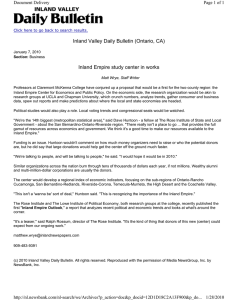
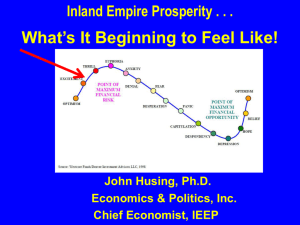

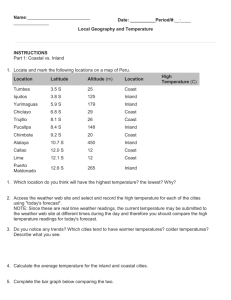

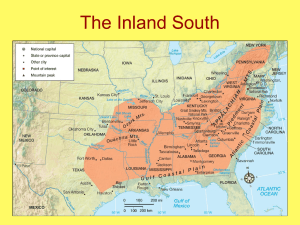


![The progress of the Northern Cities Shift in the Inland North [N=71]](http://s2.studylib.net/store/data/005278121_1-6c7b61110e83fce2e7b3ab15c9a37e24-300x300.png)


